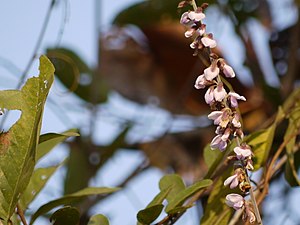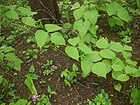Note: This is a project under development. The articles on this wiki are just being initiated and broadly incomplete. You can Help creating new pages.
Difference between revisions of "Pueraria tuberosa - Vidarikanda"
(Created page with "thumb|right|''Vidarikanda'', ''Pueraria tuberosa'' '''Vidarikanda''' is a large climber with trifoliate leave...") |
(→References) |
||
| (10 intermediate revisions by 2 users not shown) | |||
| Line 1: | Line 1: | ||
[[File:Pueraria tuberosa (Roxb. ex Willd.) DC. (6926236863).jpg|thumb|right|''Vidarikanda'', ''Pueraria tuberosa'']] | [[File:Pueraria tuberosa (Roxb. ex Willd.) DC. (6926236863).jpg|thumb|right|''Vidarikanda'', ''Pueraria tuberosa'']] | ||
'''Vidarikanda''' is a large climber with trifoliate leaves and tuberous roots. It occurs in the Himalayan tracts at low elevations and also in the hills of Central and South India. | '''Vidarikanda''' is a large climber with trifoliate leaves and tuberous roots. It occurs in the Himalayan tracts at low elevations and also in the hills of Central and South India. | ||
| − | |||
==Uses== | ==Uses== | ||
{{Uses|Joint pain}}, {{Uses|Burning sensation}}, {{Uses|Improve bodymass}}, {{Uses|Skin complexion}}, {{Uses|Improve voice quality}} | {{Uses|Joint pain}}, {{Uses|Burning sensation}}, {{Uses|Improve bodymass}}, {{Uses|Skin complexion}}, {{Uses|Improve voice quality}} | ||
| Line 11: | Line 10: | ||
==Common names== | ==Common names== | ||
| − | {{Common names|kn= | + | {{Common names|kn=ಭೂ ಸಕ್ಕರೆ ಗಡ್ಡೆ Bhoo sakkare gadde, ಗುಮ್ಮಡಿ ಗಿಡ Gummadi gida|ml=Mutukku, Palmutukku|sa=Bhukushmandi, Kandapalasah|ta=Nelapoosani|te=Darigummadi|hi=Bidarikand, Bilaikand|en=Indian kudzu}} |
<ref name="Common names"/> | <ref name="Common names"/> | ||
| Line 35: | Line 34: | ||
==Identification== | ==Identification== | ||
===Leaf=== | ===Leaf=== | ||
| − | {{Leaf|Trifoliate| | + | {{Leaf|Trifoliate|Alternate|Leaflets 5-18 x 5-12.5 cm, ovate or the terminal rhomboid, base obtuse or acute, laterals oblique at base}}<ref name="Leaf"/> |
===Flower=== | ===Flower=== | ||
| − | {{Flower|Bisexual|Raceme|Bluish purple|10|Flowers c. 1.3 cm long, bluish-purple, ternate on the nodes of racemes; pedicels c. 3 mm long. Calyx c. 7 mm long, tomentose; tube campanulate; lobes ovate | + | {{Flower|Bisexual|Raceme|Bluish purple|10|Flowers c. 1.3 cm long, bluish-purple, ternate on the nodes of racemes; pedicels c. 3 mm long. Calyx c. 7 mm long, tomentose; tube campanulate; lobes ovate.}} |
===Fruit=== | ===Fruit=== | ||
| Line 46: | Line 45: | ||
==List of Ayurvedic medicine in which the herb is used== | ==List of Ayurvedic medicine in which the herb is used== | ||
| − | + | * [[Vidaryadyasava]] | |
| + | * [[Amritaprasha ghrita]] | ||
| + | * [[Prasootikamrita lehya]] | ||
| + | * [[Gopichandanadi gulika]] | ||
| + | <ref name="Ayurvedic preparations"/> | ||
==Where to get the saplings== | ==Where to get the saplings== | ||
| Line 53: | Line 56: | ||
==How to plant/cultivate== | ==How to plant/cultivate== | ||
| − | + | hoteIt is generally propagated by seeds, but seed germination is low. Tubers and layering is also used for raising plants.<ref name="Cultivation details"/> | |
| − | |||
| − | |||
| − | |||
| − | |||
| − | |||
| − | |||
| − | |||
==Commonly seen growing in areas== | ==Commonly seen growing in areas== | ||
| Line 70: | Line 66: | ||
File:Vidari (Sanskrit- विदारी) (8632006738).jpg | File:Vidari (Sanskrit- विदारी) (8632006738).jpg | ||
File:Shimia Batraji (Bengali- শিমিআবাতরাজী) (4716596438).jpg | File:Shimia Batraji (Bengali- শিমিআবাতরাজী) (4716596438).jpg | ||
| − | + | File:Dari Gummadi (Telugu- దారి గుమ్మడి) (6926232427).jpg | |
| − | |||
</gallery> | </gallery> | ||
==References== | ==References== | ||
| − | |||
<references> | <references> | ||
| − | <ref name="Uses">[https://easyayurveda.com/2017/08/11/vidarikand-pueraria-tuberosa-indian-kudzu/ " | + | <ref name="Uses">[https://easyayurveda.com/2017/08/11/vidarikand-pueraria-tuberosa-indian-kudzu/ Uses]</ref> |
| − | + | <ref name="Cultivation details">[http://vikaspedia.in/agriculture/crop-production/package-of-practices/medicinal-and-aromatic-plants/pueraria-tuberosa Cultivation details]</ref> | |
| − | <ref name="Leaf">[http://FLOWERING PLANTS OF KERALA VER.2, N. Sasidharan | + | <ref name="Leaf">[http://FLOWERING PLANTS OF KERALA VER.2, N. Sasidharan BOTANIC DESCRIPTION]</ref> |
| − | <ref name="Common names">[http://envis.frlht.org/bot_search | + | <ref name="Common names">[http://envis.frlht.org/bot_search Vernacular names]</ref> |
| − | + | <ref name="Ayurvedic preparations">[https://easyayurveda.com/2017/08/11/vidarikand-pueraria-tuberosa-indian-kudzu/ Ayurvedic preparations]</ref> | |
| − | |||
</references> | </references> | ||
==External Links== | ==External Links== | ||
| − | * http://vikaspedia.in/agriculture/crop-production/package-of-practices/medicinal-and-aromatic-plants/pueraria-tuberosa | + | * [http://vikaspedia.in/agriculture/crop-production/package-of-practices/medicinal-and-aromatic-plants/pueraria-tuberosa Pueraria tuberosa vikaspedia.in] |
| − | * https://www.planetayurveda.com/vidarikanda.htm | + | * [https://www.planetayurveda.com/vidarikanda.htm Pueraria tuberosa on planetayurveda.com] |
[[Category:Herbs]] | [[Category:Herbs]] | ||
| − | [[Category: | + | [[Category:Fabaceae]] |
| + | [[Category:Ayurvedic herbs that don't have seed photos]] | ||
Latest revision as of 16:28, 20 July 2020
Vidarikanda is a large climber with trifoliate leaves and tuberous roots. It occurs in the Himalayan tracts at low elevations and also in the hills of Central and South India.
Contents
- 1 Uses
- 2 Parts Used
- 3 Chemical Composition
- 4 Common names
- 5 Properties
- 6 Habit
- 7 Identification
- 8 List of Ayurvedic medicine in which the herb is used
- 9 Where to get the saplings
- 10 Mode of Propagation
- 11 How to plant/cultivate
- 12 Commonly seen growing in areas
- 13 Photo Gallery
- 14 References
- 15 External Links
Uses
Joint pain, Burning sensation, Improve bodymass, Skin complexion, Improve voice quality [1]
Parts Used
Chemical Composition
Common names
| Language | Common name |
|---|---|
| Kannada | ಭೂ ಸಕ್ಕರೆ ಗಡ್ಡೆ Bhoo sakkare gadde, ಗುಮ್ಮಡಿ ಗಿಡ Gummadi gida |
| Hindi | Bidarikand, Bilaikand |
| Malayalam | Mutukku, Palmutukku |
| Tamil | Nelapoosani |
| Telugu | Darigummadi |
| Marathi | NA |
| Gujarathi | NA |
| Punjabi | NA |
| Kashmiri | NA |
| Sanskrit | Bhukushmandi, Kandapalasah |
| English | Indian kudzu |
Properties
Reference: Dravya - Substance, Rasa - Taste, Guna - Qualities, Veerya - Potency, Vipaka - Post-digesion effect, Karma - Pharmacological activity, Prabhava - Therepeutics.
Dravya
Rasa
Madhura (Sweet)
Guna
Guru (heavy), Snigdha (Slimy)
Veerya
Sheeta (cold)
Vipaka
Karma
Pitta, Vata
Prabhava
Habit
Identification
Leaf
| Kind | Shape | Feature |
|---|---|---|
| Trifoliate | Alternate | Leaflets 5-18 x 5-12.5 cm, ovate or the terminal rhomboid, base obtuse or acute, laterals oblique at base |
Flower
| Type | Size | Color and composition | Stamen | More information |
|---|---|---|---|---|
| Bisexual | Raceme | Bluish purple | 10 | Flowers c. 1.3 cm long, bluish-purple, ternate on the nodes of racemes; pedicels c. 3 mm long. Calyx c. 7 mm long, tomentose; tube campanulate; lobes ovate. |
Fruit
| Type | Size | Mass | Appearance | Seeds | More information |
|---|---|---|---|---|---|
| A Pod | 2.5-5.5 x 0.5-0.6 cm | Linear and hairy | {{{6}}} |
Other features
List of Ayurvedic medicine in which the herb is used
Where to get the saplings
Mode of Propagation
How to plant/cultivate
hoteIt is generally propagated by seeds, but seed germination is low. Tubers and layering is also used for raising plants.[5]
Commonly seen growing in areas
Tropical area, Sub tropical area
Photo Gallery
References
External Links
- Ayurvedic Herbs known to be helpful to treat Joint pain
- Ayurvedic Herbs known to be helpful to treat Burning sensation
- Ayurvedic Herbs known to be helpful to treat Improve bodymass
- Ayurvedic Herbs known to be helpful to treat Skin complexion
- Ayurvedic Herbs known to be helpful to treat Improve voice quality
- Herbs with Tuber used in medicine
- Herbs with common name in Kannada
- Herbs with common name in Hindi
- Herbs with common name in Malayalam
- Herbs with common name in Tamil
- Herbs with common name in Telugu
- Herbs with common name in Sanskrit
- Herbs with common name in English
- Habit - Climber
- Index of Plants which can be propagated by Seeds
- Index of Plants which can be propagated by Cuttings
- Herbs that are commonly seen in the region of Tropical area
- Herbs that are commonly seen in the region of Sub tropical area
- Herbs
- Fabaceae
- Ayurvedic herbs that don't have seed photos




